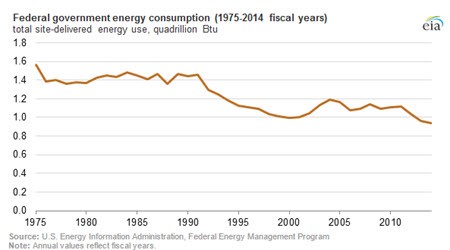WASHINGTON, Dec. 16, 2015 - Energy consumption by the federal government fell to 0.94 quadrillion British thermal units (Btu) in fiscal year 2014, the lowest level since data collection began in 1975, according to the Federal Energy Management Program (FEMP). Declines in U.S. Department of Defense jet fuel consumption account for most of the decrease.
In fiscal 2014, 78 percent of total federal energy
consumption was utilized by Defense. Civilian agencies, such as the U.S. Postal
Service, the Department of Veterans Affairs and the Department of Energy,
accounted for the next highest percentages of energy use, at 5 percent, 3
percent and 3 percent, respectively.
The Energy Independence Act of 2007 included energy reduction goals for federal agencies, including targets for reducing energy intensity and fossil fuel consumption in buildings, reducing petroleum consumption in transportation fleets and increasing the use of alternative fuels. In March 2015, an Executive Order established additional federal government goals to reduce energy consumption and energy-related emissions. Among the goals are:
- Renewable and alternative energy sources: A target of 25 percent of federal building energy to be sourced from renewable and alternative sources by 2025, with an intermediate goal of 10 percent by fiscal 2016. In fiscal 2014, 6.1 percent of the energy used in federal buildings came from renewables.
- Greenhouse gas emissions from vehicle fleets: A 30 percent decrease in per-mile greenhouse gas emissions from agency fleet vehicles by fiscal 2025. Greenhouse gas emissions from the federal fleet have fallen 3 percent over the previous five fiscal years.
- Energy intensity: An annual 2.5 percent reduction through 2025 in federal building energy intensity. From fiscal 2003 to 2014, the federal government reduced building energy intensity an average of 1.9 percent per year.
- Alternative-fuel vehicles: A target for new agency-owned vehicle acquisitions of zero emission vehicles or plug-in hybrids to make up 20 percent of all new, agency-owned vehicle acquisitions by fiscal 2020, with the share rising to 50 percent by 2025. Since 2010, the number of traditional gasoline-powered vehicles owned by government agencies has declined 10 percent. Over the same period, the number of vehicles capable of using E85 grew 30 percent, electric vehicles increased 64 percent, and diesel vehicles declined 2 percent. The agency with the largest fleet, the U.S. Postal Service, accounts for 47 percent of all agency-owned vehicles, and in the past 10 years more than half of its vehicle acquisitions have been vehicles that can run on gasoline blends of up to 85 percent ethanol.
·
#30
For more news, go to: www.Agri-Pulse.com
